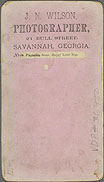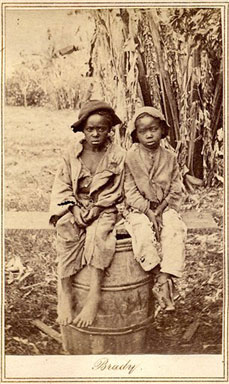A story has been circulating over the last few days about a photo of two “slave” boys, one supposedly named John, found during an estate sale in North Carolina.
The buyer was the collector Keya Morgan, whom I had not heard of before, but apparently is pretty well-known among collectors (especially for sale of the Marilyn Monroe sex tapes two years ago). According to the Associated Press story, he paid $30,000 for an album of photos of John and others (experts attributed the photo to the studio of renowned Civil War photographer Mathew Brady) and $20,000 for a bill of sale for John (from 1854).
Art historians think it’s a rare photograph of Civil War-era slave children from the 1860s. The photos and document were found at a moving sale in Charlotte in April, according to the story.
The photo presents the children and their lives in all its misery – etched in their faces and in the dusty tattered clothes they are wearing.
Practically everyone reprinted the AP story, except for blogger Kate Marcus at Before It’s News who found the same photo sold as a stereo-view card for $163 on eBay. The blogger questioned the rarity of the photo. (Stereo view card above was taken from the eBay auction site. Click on it for a fuller view.)
I also found a copy of the stereo-view card in the New York Public Library Digital Gallery, attributed to J.N. (Jerome Nelson) Wilson, who was a Savannah, Ga., photographer.
Intrigued, I decided to do some digging on my own and emailed the eBay seller. I was curious about how he/she had come across the card. He wrote back: He is a part-time Ebay seller from Connecticut with 25 years experience as an antiques and collectibles collector and estate-liquidator. He asked that I not identify him.
I’ll let him tell the story (with some minor editing):
“Since my forced retirement, I’ve had to sell off the things I’ve collected over the years (a lot of which I haven’t seen for years). One of the lots I decided to sell recently was a bag of stereo view cards and a desk top viewer I had acquired many years ago at a Wethersfield, Conn., estate sale. I sorted the cards by subject and listed them on eBay.
 One of the lots of cards was a set by J.N. Wilson of Savannah, Ga., (all of the cards in the lot had ‘Photographed and Published by: J.N. Wilson’ with a Savannah address) typeset on the back. There were six views of ‘Bonaventure’ (a former plantation near Savannah). These had typeset descriptions of the plantation and the depicted view. There were two cards with handwritten descriptions titled ‘Pine Trees’ and ‘Entrance to the Park.’ (At right is a photo of the back of the New York Library stereo view card.)
One of the lots of cards was a set by J.N. Wilson of Savannah, Ga., (all of the cards in the lot had ‘Photographed and Published by: J.N. Wilson’ with a Savannah address) typeset on the back. There were six views of ‘Bonaventure’ (a former plantation near Savannah). These had typeset descriptions of the plantation and the depicted view. There were two cards with handwritten descriptions titled ‘Pine Trees’ and ‘Entrance to the Park.’ (At right is a photo of the back of the New York Library stereo view card.)
Then there were the four cards titled ‘Plantation Life.’ Three had this typeset on the back of the card with a handwritten picture title. They were titled:
1. ‘Cotton Field’ (a view of a Black family standing in a cotton field with baskets of picked cotton).
2. ‘Cotton Field’ (a view of two young boys standing in a cotton field with a basket of picked cotton between them).
3. ‘Rory’s Cabin’ (a view of a family standing and sitting in front of their cabin).
4. This had a typeset title on a strip of white paper glued to the back of the card: ‘Plantation Life: Happy Little Nigs’ (this was a view of two young boys sitting on a board on a wood barrel in what looks like a sugar cane field).
This last card is identical to the ‘Brady’ card found in North Carolina with the exception that the stereo card is a wider view showing more background and the ends of the board they’re sitting on (the image would have been cropped to fit the CDV).
Here is what I know about stereo cards. They are taken with a ‘stereo camera.’ That is a camera with two lenses set about three inches apart. It takes a … picture with both lenses creating a double image. The images are of slightly different angles which when viewed through a stereo viewer creates a ‘3-D’ image. The camera sees the same way our eyes see – two images when combined create perspective or depth. If you take a stereo photo of a single photo, you end up with a flat image on the photo (no 3-D effect). The only way to end up with a true stereo view is to take a stereo photo from life.
All of the J.N. Wilson cards were true stereo images (I viewed them all several times through my viewer). This means that the stereo card of those two young boys could only have been made from a live sitting.
I am convinced that all of the cards were photographed by Wilson in Georgia. I have found out that his work is known to collectors and that he operated a lucrative photography business in Savannah starting in the 1870’s.
Sugar cane was never grown in North Carolina (From Sherry: In my Google search, I found that some sugar cane was grown in coastal North Carolina but it apparently was not grown in large quantities on plantations). It was a major crop along the Georgia seaboard with several large plantations on the mainland and the outlying islands.
When I saw the North Carolina card I immediately thought about what I knew about Mathew Brady. I know that Brady did not do stereo views. I know that Brady had a reputation of commandeering other photographers’ work he liked and republishing it under his name. I know his business was faltering in the 1870’s and he published any good image he found as his own.
 I was shocked to see that several ‘experts’ had authenticated the card as a Brady produced war image. Every good photography historian is intimately familiar with Brady’s catalog of work and his personal history. They should also be familiar with Wilson’s (good Southern photographers were quiet rare and the exceptions have been thoroughly studied).
I was shocked to see that several ‘experts’ had authenticated the card as a Brady produced war image. Every good photography historian is intimately familiar with Brady’s catalog of work and his personal history. They should also be familiar with Wilson’s (good Southern photographers were quiet rare and the exceptions have been thoroughly studied).
How can a ‘rare, uncirculated, unpublished’ photograph of 1860’s slave children by Brady (or his associate – Timothy H. O’Sullivan) be the subject of a stereo view card by Wilson? The Brady attribution just doesn’t add up. (Photo at left from Morgan’s LincolnImages.com was circulated on the web as the one found in North Carolina.)
There needs to be a comparison made of the North Carolina card with the stereo card. I believe that the results will show that the Brady card is a reprint of half of the Wilson card (each side of the stereo card will be slightly different). This will prove that the North Carolina card is not of slave children from the 1860’s but a photograph of two poor boys from Savannah taken in the 1870’s. Still of great interest but not of the significance given it.”
I also did some more Google digging of my own on Wilson and Brady.
Wilson was born in New York in 1827 and arrived in Savannah in 1865. He was a well-known photographer in Savannah for more than 30 years, and marketed himself tremendously in the local newspaper. He produced stereo views of Bonaventure Cemetery and other sites in the city, steamers in Florida, black chimney sweeps in Savannah, Fort Pulaski in Georgia, the Green House in Macon, Ga., rice fields, orange groves, camp scenes, fishing parties and more. His works are in the Smithsonian American Art Museum and the New York Public Library Digital Gallery.
Brady is renowned for his photographs of the Civil War and portraits of Abraham Lincoln and practically all of the other presidents. He also photographed J.H. Rainey, the first African American member of the House of Representatives. His portraits are in many collections, including the National Portrait Gallery, Metropolitan Museum of Art, Musee d’Orsay in Paris and the Museum of Modern Art.
As his eyesight failed, Brady sent out teams of photographers to capture the war, according to several websites. He also purchased photos from other photographers and stamped them “Photograph by Brady,” without giving many of them credit – to the rancor of those photographers. A photo of the Lakota Chief Red Cloud was taken by Brady photographer Alexander Gardner in 1872 at the studio.
Despite what the experts said, I also found photos from the Civil War era of slave children, including this one by O’Sullivan and this one from Virginia.


Excellent & fasinating research Sherry. As a former B&W lab tech in Washington, DC I was given a box full of late 1870’s – early 1900’s glass negatives to clean, preserve & contact print. Your article brings back the thrill of handling history. Thanks for your historical due diligence.
Thanks, Bruce. Those stereo-view cards (and the wooden viewers) & negatives come up at auction often and I always bid on them. Unfortunately, there are other bidders who want them just as much as I do, and they always outbid me. I figure I’ll get lucky at some point and win one of those bids.
Great article, I am J N Wilson’s great granddaughter and have been collecting stereoviews of his for a few years now, and was the bidder that got outbid with one second left on the ebay collection with this card in it.
Then a few days later saw the article in the paper about the sale of the cdv. and knew that it was J N’s stereoview. In past searches of J N, I had seen this card in the New York Public Library collection. Thanks for the info……
Thanks for writing, Tina, and for providing additional information. This has been a very interesting story, and I was very happy to find out more about your great-grandfather through my Google search.
That’s very interesting. Thanks Sherry.
Fantastic article, Sherry! I’m so happy that more people are being made aware of this incredible story.
– Kate Marcus